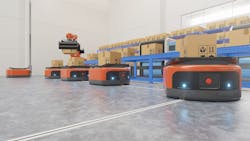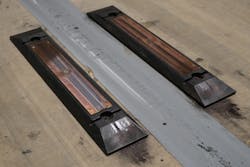The markets for automated guided vehicles (AGVs) and autonomous mobile robots (AMRs) continue to grow. In semiconductor production and pharmaceuticals, for example, robots automate material transport in sensitive production environments, specifically those using clean rooms to control contamination. But that mobile equipment needs to be powered.
The same solution will work for AGVs and AMRs, explains Tommy Hessler, CEO of America in Motion (AIM). "In general, AMRs are smaller and therefore lighter, but it just means that the sizing of the components will need to be a bit different," he notes. "For clean rooms, there are some limits as to what can be done—for example, the wheels and the small amount of dust they generate as they roll or wear can be a problem for higher classifications."
Because of the introduction of particles during mechanical power supply, AGV and AMR systems are typically fitted with inductive charging systems.
The charging connection is a big problem, so inductive charging is the best alternative, suggests Hessler. "It is costly to install the coil wires in the floor, and it makes the free-ranging AGV or AMR not so free as it needs to drive where the inductive coils are for a lot of the time to receive enough charge," he explains. "However, it is contact-free and generates no dust pollution for a clean-room application." The navigation also needs to be looked at, as light detection and ranging (LiDAR) is often used for navigation. "These have a motor in them, and some are not very sealed, so there is a potential for dust to be generated by the rotating laser mirror; however, a good unit should be completely sealed and present no issues," says Hessler, who also spoke with partner publication Machine Design about the Industrial Internet of Things (IIoT) in 2020.
The International Organization for Standardization (ISO) published a revised clean-room standard in 2016. Automotive manufacturing, food production, aerospace and pharmaceuticals utilize controlled and classified clean rooms—zones with highly controlled contaminants that can affect processes and products.
ISO 14644-1:2015, Clean rooms and associated controlled environments—Part 1: Classification of air cleanliness by particle concentration; and ISO 14644-2:2015, Clean rooms and associated controlled environments—Part 2: Monitoring to provide evidence of cleanroom performance related to air cleanliness by particle concentration, are the industry standards used to monitor and classify clean rooms, which enable a large number of high-technology industries.
Recommendations from Dr. Udo Gommel, head of the Ultraclean Technology and Micromanufacturing department at Fraunhofer IPA can help to maintain regulated cleanliness:
• Only materials and components suitable for clean rooms should be used.
• Only low-emission lubricants should be used.
• If possible, tribologically optimized material combinations should be used.
• Surfaces must be easy to clean.
• The surfaces used should have the lowest possible outgassing behavior.
• The undercuts of material combinations/surfaces should be as small as possible.
• Good chemical resistance should be maintained.
• The materials used should have low metabolic capacity.
For energy, AIM’s Hessler recommends a sealed battery. "And it needs to be oversized," he suggests. "The depth of discharge (DOD) should not be 100%, but more like 20% to 40%. This means that the battery operates in the range of 60% to 80% full or 40% to 80% full." In general, absorbent-glass-mat (AGM) lead acid batteries that are sealed and have very low internal resistance are good for the 20% DOD, says Hessler, and lithium ion/ferrite-style batteries are good for the 40% DOD setting.
"I am not aware of any issues or special concerns that actually come into play for powering AGVs/AMRs in a clean-room environment," says Alex Bonaire, product manager—robotics, Omron Automation. "Clean rooms are contamination-controlled spaces, so the issue in those areas is relative to things that get in the air, which is not related to powering a robot. The only thing I'd perhaps say is that, if an AMR/AGV is going to have its charger located inside of a clean-room environment, it is possible that a robot that charges with physical electrical contact could create contamination when engaging with the charging paddles so that engagement would need to be evaluated, although it is likely very low-risk because those charging contacts are located very low to the floor. If the environment is so sensitive that that could be an issue, then it is recommended that the charger for the AMR be located outside of the clean-room environment or a wireless charger is utilized within the clean-room environment to eliminate potential contamination of a contact type charging method."
The worker shortage has impacted manufacturers’ needs to automate transport processes, and AGVs and AMRs have seen increased implementations. Transporting resources in clean-room environments requires special considerations as any contamination can lead to downtime. Particles floating in the air that pollute a batch of medicines or damage highly sensitive semiconductor substrates affect the bottom line. For those sensitive environments, components on automated-transport vehicles, including the power supply, should be designed with cleanliness in mind.
Clean-room users of AGVs and AMRs can turn to inductive point charging systems. Transfer of power is contactless, following the principle of magnetic induction. As soon as a vehicle has reached the loading pad of an inductive point charging unit, the charging process starts automatically at full power within a second. Battery fast-charging systems are encapsulated and can operate without mechanical components, minimizing particle generation from charging.
“Clean-room-rated AGVs and AMRs are very niche products, often due to the sensitive nature of the applications and materials handled and the market size,” explains David Roach, senior product manager, global products and solutions, mobile and robotic solutions, Dematic. “With that in mind, inductive charging is the best way to charge AGVs and AMRs within the clean-room environment. Inductive charging is wireless, or cordless, charging that is meant to transfer power without the need for mechanical contact using electromagnetic induction. The AGV or AMR only needs to be positioned near a charging point—docking station or inductive pad—without extreme precision for the power transfer to occur. Indifferent from clean-room classification, this method eliminates residue created by physical contactors or electrical arcs produced by a vehicle misalignment or docking using mechanical contact or controls.”
In addition, robots’ batteries can be charged at machines via in-process charging with the quantity of energy they need for their transport tasks, allowing continuous 24/7 operation without interrupting transport work for charging breaks.
Charging pads can be installed completely flush with the floor, at the side or like a tile, so as to avoid impeding the flow of work and tripping risk. Charging points can be relocated when necessary, and the likelihood of broken or dirty contacts is reduced and eliminated.
To prevent oxide from building and achieve good electrical contact, one established method is to rub the two contacts about an inch under a contact pressure to achieve self-cleaning, warns Ebert. “This is the part of the process where metal dust is generated,” he says. “This metal dust is often a mix of copper and brass and can be very harmful to different types of production processes. Another downside of this self-cleaning approach is that the contacts wear off and need to be replaced after a certain number of docking cycles (Figure 1).”
Ebert sees little difference in charging-technology requirements for AGVs or AMRs. “The only difference which could play a role is that an AGV is very likely guided optically or with a magnetic band and therefore has a better positioning tolerance than an AMR, which uses free navigation,” he explains. “Wireless charging has a way bigger positioning tolerance acceptance than charging contacts and can therefore facilitate deployment and the docking processes.”
About the Author
Mike Bacidore
Editor in Chief
Mike Bacidore is chief editor of Control Design and has been an integral part of the Endeavor Business Media editorial team since 2007. Previously, he was editorial director at Hughes Communications and a portfolio manager of the human resources and labor law areas at Wolters Kluwer. Bacidore holds a BA from the University of Illinois and an MBA from Lake Forest Graduate School of Management. He is an award-winning columnist, earning multiple regional and national awards from the American Society of Business Publication Editors. He may be reached at [email protected]

Leaders relevant to this article:


